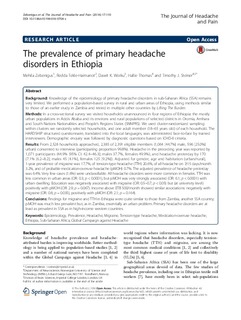| dc.description.abstract | Background
Knowledge of the epidemiology of primary headache disorders in sub-Saharan Africa (SSA) remains very limited. We performed a population-based survey in rural and urban areas of Ethiopia, using methods similar to those of an earlier study in Zambia and tested in multiple other countries by Lifting The Burden.
Methods
In a cross-sectional survey we visited households unannounced in four regions of Ethiopia: the mostly urban populations in Addis Ababa and its environs and rural populations of selected districts in Oromia, Amhara and South Nations Nationalities and People’s Regions States (SNNPRS). We used cluster-randomized sampling: within clusters we randomly selected households, and one adult member (18–65 years old) of each household. The HARDSHIP structured questionnaire, translated into the local languages, was administered face-to-face by trained interviewers. Demographic enquiry was followed by diagnostic questions based on ICHD-II criteria.
Results
From 2,528 households approached, 2,385 of 2,391 eligible members (1,064 [44.7%] male, 596 [25.0%] urban) consented to interview (participating proportion 99.8%). Headache in the preceding year was reported by 1,071 participants (44.9% [95% CI: 42.4–46.3]; males 37.7%, females 49.9%), and headache yesterday by 170 (7.1% [6.2–8.2]; males 45 [4.1%], females 125 [9.2%]). Adjusted for gender, age and habitation (urban/rural), 1-year prevalence of migraine was 17.7%, of tension-type headache (TTH) 20.6%, of all headache on ≥15 days/month 3.2%, and of probable medication-overuse headache (pMOH) 0.7%. The adjusted prevalence of headache yesterday was 6.4%. Very few cases (1.6%) were unclassifiable. All headache disorders were more common in females. TTH was less common in urban areas (OR: 0.3; p < 0.0001), but pMOH was very strongly associated (OR: 6.1; p < 0.0001) with urban dwelling. Education was negatively associated with migraine (OR: 0.5–0.7; p < 0.05) but (at university level) positively with pMOH (OR: 2.9; p = 0.067). Income above ETB 500/month showed similar associations: negatively with migraine (OR: 0.8; p = 0.035), positively with pMOH (OR: 2.1; p = 0.164).
Conclusions
Findings for migraine and TTH in Ethiopia were quite similar to those from Zambia, another SSA country; pMOH was much less prevalent but, as in Zambia, essentially an urban problem. Primary headache disorders are at least as prevalent in SSA as in high-income western countries. | nb_NO |
| dc.description.localcode | This article is distributed under the terms of the Creative Commons Attribution 4.0 International License (http://creativecommons.org/licenses/by/4.0/), which permits unrestricted use, distribution, and reproduction in any medium, provided you give appropriate credit to the original author(s) and the source, provide a link to the Creative Commons license, and indicate if changes were made. | nb_NO |

